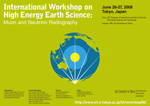For
the purpose of radiography, recent developments in muon and neutrino
detectors make it possible to detect the muon and neutrino particles
with high statistics and therefore in great detail. Because of their
relevance for a variety of related fields of research, neutrino and
muon physics will be a major focus in geophysical research. It is
likely that several crucial questions concerning geodynamics and
related fields such as volcanology and tectonics will be answered. The
successful operation of such detectors, therefore, may very well
represent the birth of a new technique for the study of fundamental
issues in these fields.
The 1st International workshop on
high energy earth science; muon and neutrino radiography is held on
26-27 June 2008: http://www.eri.u-tokyo.ac.jp/ht/workshop08/index.html.
The workshop is devoted to addressing the main current issues in this
research area to form a research network aimed at fostering
crossdisciplinary scientific collaboration on neutrino physics, muon
phyics, positron physics and geophysics. The purpose of the workshop is
to develop a new geophysical insight into recent progress in muon and
neutrino radiography design, the associated R&D program, and
evolving geological and geophysical program that motivates high energy
earth science. In view of the great success of the workshop, we
propose a proceeding of the International Workshop on High Energy Earth
Science as a special issue of Earth, Planets and Space. The publication
will not be limited to papers presented in the meeting and, therefore,
we encourage contributions from anybody interested. Contributors to
this special issue should submit their papers to the EPS editorial
office either by post or by e-mail (eps@terrapub.co.jp), following the
instructions for regular EPS submission. For details, please visit the
following web page:
http://www.terrapub.co.jp/journals/EPS, and click on gInformation for Contributors.h
Please
state gFor Special issue for the High energy earth science: muon and
neutrino radiography" clearly in the covering letter that accompanies
the submission. We encourage electronic submissions. After papers are
accepted, the authors will receive instructions for the final
manuscript from the editorial office. The deadline for manuscript
submissions for this special issue is 31 October 2008. This special
issue will hopefully be published in early 2009.
For more
information on this special issue, please contact the corresponding
editor (Hiroyuki Tanaka, ht@riken.jp); questions on manuscript
preparation should be addressed to the EPS editorial office.
Note:
EPS accepts manuscripts of original research contributions only, and
so-called greview papersh will not be accepted. EPS will review all the
manuscripts before the publication.
|



